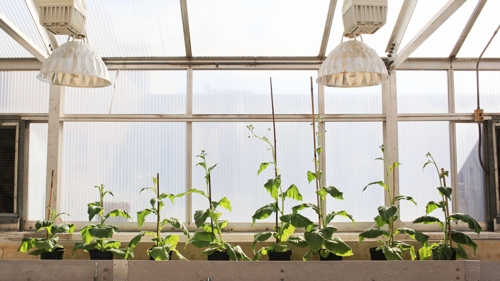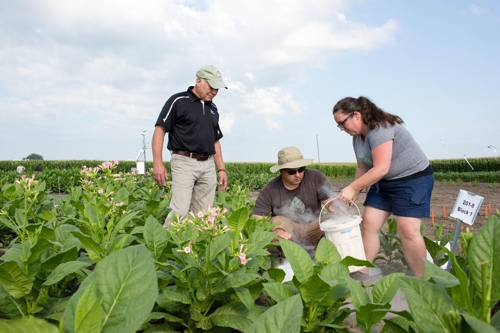미국 연구팀 “담배에 광호흡 대사경로 조절 유전자 주입·재배 실험 성공”
미국 연구팀이 식물의 광합성 효율이 높아지도록 대사경로를 조절하는 유전자를 식물체에 이식, 담뱃잎의 생산량을 40% 늘리는 데 성공했다.
미국 어바나-샴페인 일리노이대 도널드 오르트 교수팀은 4일 국제학술지 ‘사이언스'(Science)에서 식물에 인공 대사 경로를 통해 광호흡(photorespiration)의 비효율과 부작용을 최소화하는 유전자를 주입, 생산성을 크게 높이는 데 성공했다고 밝혔다.

일반 담배와 유전자 이식 담배 성장 비교 광호흡 대사 경로를 조절하는 유전자가 이식된 담배 개체들(오른쪽 4개)이 일반 담배들(왼쪽 4개)보다 같은 환경에서 훨씬 빠르고 크게 자라고 있다. [Claire Benjamin/RIPE Project 제공]
오르트 교수는 “유전자 이식을 통해 광호흡 대사 경로를 조절, 작물 생산량을 40% 늘릴 수 있었다”며 이 방법을 사용하면 미국 중서부 지대에서 매년 식물 광호흡에 허비되는 열량만 아껴도 최대 2억명을 더 먹여 살릴 수 있을 것이라고 말했다.
작물 생산성을 높이는 노력은 최근 살충제나 비료 사용량을 늘리거나 관개시설을 개선하는 등의 방법이 거의 한계에 부딪힘에 따라 식물의 광합성 효율을 높이는 데 초점이 맞춰지고 있다.
식물은 이산화탄소와 물을 빨아들이고 광합성을 해 바이오매스를 만든다. 하지만 대부분 작물에서는 광합성 과정에 결함이 발생하고 식물은 광호흡으로 이 결함을 해결하지만 이 과정에 많은 에너지가 소모돼 생산량이 상당히 감소한다.
식물에서는 ‘루비스코'(RuBisCO) 효소가 공기 중 이산화탄소를 고정해 광합성에 사용되도록 하는데, 루비스코가 산소와 반응하면 쓸모없는 부산물이 생성되며 식물체는 광호흡을 통해 이 부산물을 다시 유용한 분자로 바꾼다.
하지만 광호흡 과정에는 많은 에너지가 소모돼 광합성 효율이 떨어지고, 이로 인해 일부 작물에서는 생산량이 20~50%나 감소한다.
연구팀은 유전자 조작이 쉽고 연구에 적합한 담배를 모델 작물로 사용, 원래의 광호흡 대사 경로 대신 루비스코 산화 부산물이 더 효율적으로 재활용될 수 있는 인공 대사 경로를 도입하는 유전자를 삽입한 뒤 온실과 야외에서 재배했다.

광호흡 대사경로 조절 유전자 주입 담배 재배 실험[Claire Benjamin/RIPE Project 제공]
그 결과 새로운 인공 대사 경로를 가진 식물체는 온실과 야외 재배 환경에서 모두 더 빠르고 크게 성장하는 것으로 확인됐으며 바이오매스 생산량은 40%나 증가했다.
논문 제1 저자인 폴 사우스 박사는 “광호흡은 식물이 성장하고 생산량을 늘리는 데 사용될 소중한 에너지와 자원을 소모, 광합성 효율을 떨어뜨린다”며 인공 대사 경로는 이런 비효율적인 광호흡을 거치지 않게 해주는 지름길 역할을 한다고 설명했다.
이 연구는 ‘빌 앤드 멜린다 게이츠 재단'(Bill & Melinda Gates Foundation) 등이 광합성 효율을 높여 지속 가능한 식량난 해결 방안을 찾기 위해 추진하고 있는 ‘광합성 효율 향상'(RIPE) 프로젝트의 일부로 진행되고 있다.
이 기술이 식량 작물에 적용돼 규제 당국의 허가를 얻는 데는 10년 이상이 걸릴 것으로 예상되지만, RIPE 연구팀은 이 프로젝트의 성과를 사하라 남부 아프리카와 동남아시아의 소규모 농민들에게 무상 제공할 계획이라고 밝히고 있다.
(원문: 여기를 클릭하세요~)
美연구진 “광호흡 효율 높여 2억명 먹여살릴 수 있는 기술”

미국 일리노이대/사이언스 제공연구진, 아프리카 및 동남아 등 개도국에 무상제공 예정
미국 과학자들이 식물의 대사경로를 조절하는 유전자를 이식해 광합성 효율을 높임으로써 생산량이 절반 가까이 증가시키는데 성공했다.
미국 농무부 글로벌체인지 및 광합성연구단, 일리노이대 유전생물학연구소, 곡물과학과, 식물학과 공동연구팀은 담뱃잎에 광호흡의 효율성 저하를 막아주는 유전자를 주입해 작물 생산량을 40% 가까이 높이는데 성공하고 세계적인 과학저널 ‘사이언스’ 4일자에 발표했다. 이번 연구는 빌 앤드 멜린다 게이츠 재단이 광합성 효율을 높여 지속 가능한 식량난 해결방안을 찾기 위해 추진하고 있는 광합성효율향상(RIPE) 프로젝트 일부로 진행됐다.
지난 세기 과학기술은 기하급수적으로 늘어나는 인구에 비해 작물 생산성은 산술급수적으로만 증가해 기아에 시달릴 것이라는 영국의 통계경제학자 멜서스의 예언을 보기 좋게 빗나가게 만들었다. 실제로 살충제나 비료 사용량을 늘리고 관개시설을 개선하는 등의 방법으로 작물 생산성을 예상 밖으로 높일 수 있어 ‘제2의 녹색혁명’이라고 불리기도 했다.
그러나 이 같은 방법도 이제 한계에 부딪쳐 최근에 과학자들은 식물의 광합성 효율을 높이는 방식으로 생산량 증대를 꾀하고 있다.
식물은 햇빛, 이산화탄소, 물을 이용해 사람이 활용할 수 있는 최종산물을 만들어 낸다. 그렇지만 광합성 과정에 결함이 발생하는 경우가 많아 식물은 광호흡으로 결함을 해결하지만 이 과정에서 에너지 투입이 커 생산량은 감소하게 된다. 실제로 일부 작물에서는 광호흡으로 인해 생산량이 적게는 20%에서 많게는 50% 가까이 줄어들기도 한다.
연구팀은 유전자 변형이 쉬운 담배를 이용해 실험을 실시했다. 연구팀은 식물 본연의 광호흡 대사경로 대신 루비스코 산화 부산물이 더 효율적으로 활용할 수 있는 유전자를 주입해 온실과 야외에서 재배, 관찰했다. 루비스코는 공기 중 이산화탄소를 고정해 광합성에 사용되도록 하는 효소로 루비스코가 산소와 반응하면 쓸모없는 부산물이 만들어지고 식물체는 광호흡으로 이 부산물을 유용한 분자로 바꾸는 것으로 알려져 있다.
그 결과 루비스코 유전자가 주입된 식물은 온실과 야외 환경에서 모두 더 빠르고 크게 자라는 것으로 확인됐으며 담배 생산량도 40% 이상 늘어난 것으로 확인됐다.
도널드 오르트 일리노이대 식물학과 교수는 “광호흡은 식물이 성장하고 생산량을 늘리는데 사용되는 에너지와 자원을 소모해 광합성 효율을 떨어뜨린다”며 “이번 연구는 유전자 이식을 통해 비효율적인 광호흡을 거치지 않도록 만들어 생산량을 획기적으로 늘릴 수 있다는 것을 보여준 것”이라고 말했다.
(원문: 여기를 클릭하세요~)
Improving crop yield
The enzyme ribulose 1,5-bisphosphate carboxylase-oxygenase (RuBisCO) is one of the most abundant proteins on Earth. During photosynthesis, it assimilates atmospheric CO2 into biomass and hence is a major driver of the global carbon cycle. However, the enzyme is catalytically imperfect. It accepts not only CO2 as a substrate, but also O2, which leads to the formation of a toxic byproduct, 2-phosphoglycolate (2-PGlycolate) (1). The metabolic pathway photorespiration detoxifies 2-PGlycolate, and it is essential for performing photosynthesis in an O2-containing atmosphere. Importantly, photorespiration causes a 20 to 50% yield penalty, depending on the environmental conditions and the type of photosynthesis employed (2). Multiple attempts have been undertaken to overcome this yield penalty and thereby increase biomass production in plants, with limited success to date. On page 45 of this issue, South et al. (3) present a synthetic pathway that fully detoxifies 2-PGlycolate inside plant chloroplasts. Transgenic tobacco plants expressing this pathway show strongly enhanced biomass production in field trials, suggesting that this could be used to improve crop yields.
The fixation of O2 by RuBisCO in chloroplasts leads to high rates of photorespiration and a concomitant loss of CO2 from mitochondria. A synthetic bypass and the restricted activity of PLGG1 allow metabolism of glycolate with release of CO2 inside of the chloroplasts, which promotes CO2 fixation by RuBisCO and improves yield.
GRAPHIC: A. KITTERMAN/SCIENCE
Photorespiration is an essential metabolic repair pathway in all organisms that perform oxygenic photosynthesis, from cyanobacteria, through algae, to land plants (2, 4). Core photorespiratory metabolism comprises nine enzymatic steps that are distributed over chloroplast, peroxisome, and mitochondrion within a plant cell. It converts detrimental 2-PGlycolate into the Calvin-Benson cycle intermediate 3-PGlycerate and thereby returns 75% of otherwise unusable carbon to photosynthetic metabolism. However, during this salvage pathway, 25% of previously fixed CO2gets lost, and energy is consumed (see the figure). Hence, albeit essential, photorespiration is also considered a wasteful and inefficient process (2). Accordingly, photorespiration has been identified as a prime target for engineering to improve crop yields, and diverse strategies have been developed to improve photosynthetic efficiency by reducing photorespiration and/or enhancing the CO2 fixation processes. Some of these attempts are inspired by naturally occurring CO2-concentrating mechanisms present in, for example, cyanobacteria and algae. Others are based on implementing synthetic metabolic routes to redirect the canonical pathway of CO2 assimilation and photorespiration (5).
South et al. revisited two previously established synthetic bypasses of photorespiration (6, 7) and tested a newly designed pathway in genetically modified tobacco plants. These pathways aim to completely metabolize the photorespiratory metabolite glycolate, which is generated from 2-PGlycolate by phosphoglycolate phosphatase within the chloroplast. They release CO2 close to RuBisCO (not in mitochondria, as in natural photorespiration) to increase the ratio of CO2 to O2fixation. Alternative pathway (AP) 1 originates from the bacterium Escherichia coli and uses five enzymes that oxidize glycolate via glyoxylate and tartronic semialdehyde to glycerate (6). The second bypass, AP2, uses three enzymes that convert glycolate via glyoxylate and malate to acetyl–coenzyme A (CoA). AP2 also requires the expression of catalase for detoxification of hydrogen peroxide that results from conversion of glycolate to glyoxylate by glycolate oxidase (7). AP1 and AP2 were previously shown to increase biomass (6, 7). AP3 was newly designed by South et al. In AP3, only two transgenes had to be introduced into the plant chloroplast: a glycolate dehydrogenase that converts glycolate into glyoxylate derived from the green alga Chlamydomonas reinhardtii was redirected to tobacco chloroplasts, and similar to AP2, a malate synthase was expressed to convert glyoxylate to malate and eventually to acetyl-CoA via the native chloroplast-resident nicotinamide adenine dinucleotide phosphate (NADP)–malic enzyme (see the figure). Using the green algal glycolate dehydrogenase instead of plant glycolate oxidase prevents production of hydrogen peroxide, and hence additional expression of catalase is unnecessary.
Two important differences from the original pathway designs (6, 7) represent major advances. Besides introducing a synthetic bypass, South et al. also reduced the expression of PLASTIDIAL GLYCOLATE/GLYCERATE TRANSPORTER 1 (PLGG1) (8). This modification was suggested previously (9) to increase the potential of synthetic bypasses, because it restricts the export of glycolate from chloroplasts and hence promotes its consumption by the synthetic bypass. A larger portion of glycolate is decarboxylated within the chloroplast by the synthetically engineered bypass, leading to enhanced CO2 fixation activity of RuBisCO. This comes with an impressive yield gain of more than 40%. Importantly, yield improvements positively correlated with the expression levels of the introduced enzymes, which highlights the importance of high and balanced expression of the transgenes. Typical annual yield gains in crop breeding are below 2%; hence, the synthetic pathway holds potential for a step change in yield improvement by genetic modification of crops. In contrast to earlier work (6, 7), the pathways were introduced into the model crop tobacco, which was investigated not only in growth chambers and greenhouses, but also in field trials. Thus, the yield gains manifested in an agriculturally relevant scenario and not only in controlled environments.
Importantly, the synthetic pathways open new avenues for reevaluating long-standing hypotheses regarding the importance of photorespiration beyond detoxification of 2-PGlycolate. Photorespiration is considered indispensable for photosynthesis in an O2-containing atmosphere, and mutants defective in photorespiration can only survive in a high-CO2 atmosphere (10). Genetic suppressor screens on such mutants have been unsuccessful to date. The study of South et al.demonstrates that a photorespiratory phenotype (repression of PLGG1) can be suppressed by metabolic engineering. The true reason or reasons for the indispensability of photorespiratory metabolism are intensely debated and include the detoxification of 2-PGlycolate; carbon salvage; biosynthesis of the amino acids glycine and serine (11); generation of activated C1-units; and protection from photoinhibition and dissipation of excess excitation energy (2, 12, 13). The work of South et al. indicates that plant metabolism adapts to the synthetic pathways and compensates for reduced flux through the peroxisomal and mitochondrial parts of native photorespiration. This implies that 2-PGlycolate detoxification and carbon recycling are the critical functions of photorespiration.
Recently, the optimization of a mechanism that protects plants from excess light, nonphotochemical quenching (NPQ), which is dissipation of excess excitation energy as heat, afforded appreciable yield gains (14). It is important to test whether a combination of engineered photorespiration with optimization of NPQ will enable additive yield gains. Realizing the yield gains afforded by the synthetic bypass in crops will require genetic engineering because the required enzymes are not present in plant genomes and hence cannot be targeted by breeding or genome editing technologies.
(원문: 여기를 클릭하세요~)
Fixing photosynthetic inefficiencies
In some of our most useful crops (such as rice and wheat), photosynthesis produces toxic by-products that reduce its efficiency. Photorespiration deals with these by-products, converting them into metabolically useful components, but at the cost of energy lost. South et al. constructed a metabolic pathway in transgenic tobacco plants that more efficiently recaptures the unproductive by-products of photosynthesis with less energy lost (see the Perspective by Eisenhut and Weber). In field trials, these transgenic tobacco plants were ∼40% more productive than wild-type tobacco plants.
Science, this issue p. eaat9077; see also p. 32
(원문: 여기를 클릭하세요~)
